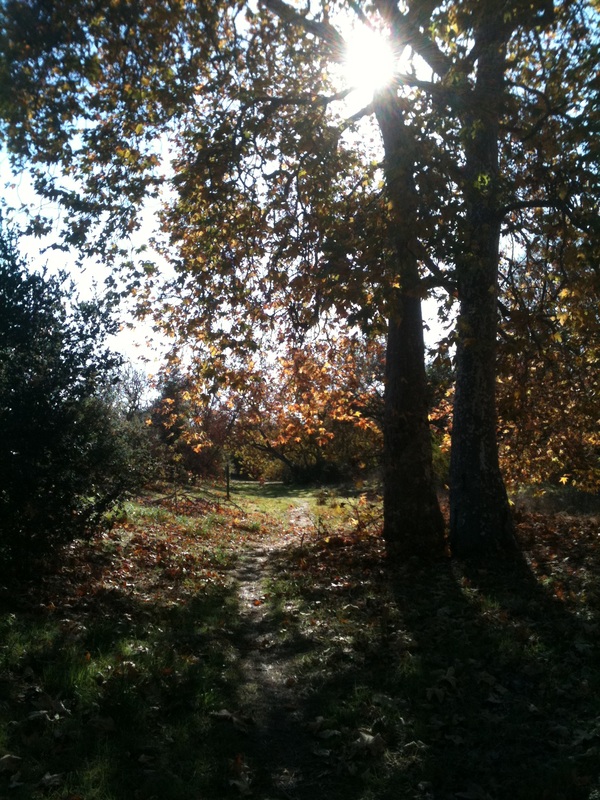|
This is an excerpt from the book I'm writing about the extraordinary life of a local Spanish-Mexican matriarch, a first generation colonist of San Jose. I wanted to share bits and pieces as I go, with the caveat that, like all works in process (and life), it's subject to change. Fog swirls over the six-by-six excavation. A rusted metal liner surrounds some serpentinite stones, each scabbed with bronze moss and edged with tufts of weeds. The allure to archaeologists would be unclear, but for the white words stenciled inside the frame: PRESIDIO DE SAN FRANCISCO, 1780 CHAPEL, NAVE and ALTAR. This is a piece of the chapel’s foundation -- the place where a commandante once saved a little girl’s soul. Long before I had ever heard of Maria Zacarias Bernal Berreyesa, I intimately knew her rural league of land in south San Jose. The former Rancho San Vicente lies between two ranges near my home in the foothills, and my children attended school on a developed corner of the old ranch, just a stone’s throw from the creek along its border. On warm afternoons I would pick them up and take them directly to Los Alamitos to rinse away the day’s restraints, to feed ducks, build dams, and skim stones. But I would visit most often with my dog at dawn or dusk, when I heard only water, wind, and birds, and saw only creatures too cautious to come very close – though sometimes a rabbit or bobcat would dart from the shrubs. It was a place of solitude and meditation, where I was reminded that nothing is wasted or ugly or meaningless -- that new life always grows from the broken, fallen, old, and scarred. And the land was my touchstone when suburbia threatened my soul. In the twenty-four years I had been walking the two-mile loop around Los Alamitos Creek, I had noticed too many oddities not to wonder what might haunt it. The property exuded a known history through its rusted found objects and proximity to old quicksilver mines, but I was certain something else was embedded there, something deeper than mercury mine shafts and cinnabar caves, something richer than ore. I was intrigued by the stories I saw in particular places. The dark green surf of non-native vinca flooding a bank, the face of a snarling devil in the knots of an oak, a vignette of small animal skulls aligned in the mud. Places in the path where my dog refused to go, and when carried there, she trembled in my arms. The distorted scar of an arrow carved in a trunk. Crickets creaking in the middle of the day, frogs croaking at dawn, vultures hunkering together on rocks in the middle of the creek. Rusted mattress springs. Rotted chunks of lumber, bits of tumbled brick, a metal cart beneath the gritty silt. Thick paddles of cactus poking through patches of weeds. Unlikely pedestrians had also piqued my interest over the years. I repeatedly encountered people who did not conform to the standard suburban scene: A muttering woman with long silver hair wearing gypsy skirts and Keds, perpetually walking local streets and trails – a woman I had seen in my childhood, too, incessantly tracing another county’s veins . A hulking, sixty-something man preceded by five loose Chihuahuas; he introduced himself as a native Czech jazzman who ice skates at sunrise each day at the local rink. And then there was Ray, a convivial, middle-aged man whose grin, ponytail, and John Lennon glasses made him seem forever (and happily) stuck in the Summer of Love. The collective, recurring nature of these anomalies had always implied mystery along the creek, an impression of something significant under its skin. It was like being in an empty gothic chapel, where all is in perfect order and exudes simplistic grace, yet one senses hidden things wedged in the vaults, invisible stains seeping in through the fretwork. The beauty and peace of the place might still provide comfort -- but the aberration nonetheless exists, residual baseness permeating art. One fortunate day, Mary Berger and Heidi McFarland of the Almaden Quicksilver Mining Museum put a name to that sense. It did not surprise me to learn that the land that had been so meaningful to me had been of enormous significance to another woman – in fact, to the nation. But what Mary and Heidi told me about her life prickled my skin and touched my heart. What I learned from her great-nephew, San Jose's official historian and Superior Court judge Paul Bernal, sparked my quest. Together, their words began a journey that has led me here today, searching for Maria Zacarias.
Thank you for reading this excerpt from MINE -- your comments are always welcome! If you'd like to know when I post another, please subscribe for updates.
6 Comments
Ingrid
2/27/2014 12:27:20 am
Your ability to draw me into this after just the first paragraph...hauntingly wonderful way to begin my day. Thank you.
Reply
Jenny Walicek
2/27/2014 01:32:48 am
Oh Ingrid I'm so glad to hear from you -- I miss you dearly! Thank you for taking the time to comment and for your warm words. It's kind of scary (actually terrifying) putting this stuff out there, but deep breath and here goes!
Reply
Colette
3/10/2014 08:54:16 am
LOVE THIS, Jenny. Wonderful, beautiful, and so, so interesting! Can't wait to come to your reading/book signing!
Reply
Jenny
3/11/2014 03:59:56 am
Aaww THANKS Colette! So nice to hear from you! How's your own book coming along? Would you love to help promote your tour (especially if it includes France)!
Reply
Cindi Fernandez
4/9/2015 08:02:36 am
I would love to know how to get a copy of your book, Jenny.
Reply
4/9/2015 08:14:04 am
Thank you, Cindi -- the manuscript is being considered by the publisher of my dreams, so I'm crossing my fingers!!
Reply
Leave a Reply. |
Welcome to
|







 RSS Feed
RSS Feed